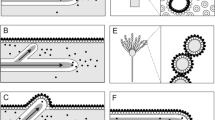Abstract.
Class I and class II hydrophobins are small secreted fungal proteins that self-assemble at hydrophilic–hydrophobic interfaces into amphipathic films. Apart from eight conserved cysteine residues, the amino acid sequences between and within both classes have diverged considerably, and this is reflected in the biophysical properties of these proteins. For instance, assemblages of class I hydrophobins are highly insoluble, while those of class II hydrophobins readily dissolve in a variety of solvents. The properties of hydrophobins make them interesting candidates for use in a wide range of medical and technical applications. Each application has its own requirements, which may be met by using specific natural variants of hydrophobins or by modifying hydrophobins chemically or genetically. Applications also require high production systems for hydrophobins. In this respect, filamentous fungi that naturally secrete hydrophobins into the medium seem to be the hosts of choice.
Similar content being viewed by others
Author information
Authors and Affiliations
Additional information
Received revision: 2 February 2001
Electronic Publication
Rights and permissions
About this article
Cite this article
Scholtmeijer, .K., Wessels, .J. & Wösten, .H. Fungal hydrophobins in medical and technical applications. Appl Microbiol Biotechnol 56, 1–8 (2001). https://doi.org/10.1007/s002530100632
Received:
Accepted:
Issue Date:
DOI: https://doi.org/10.1007/s002530100632




